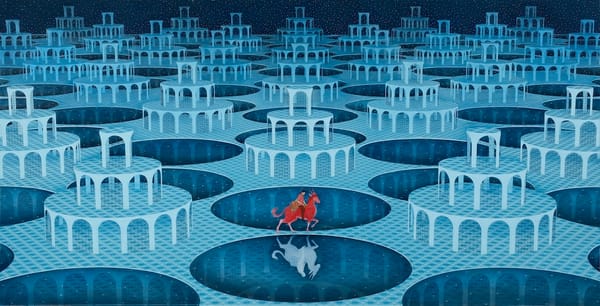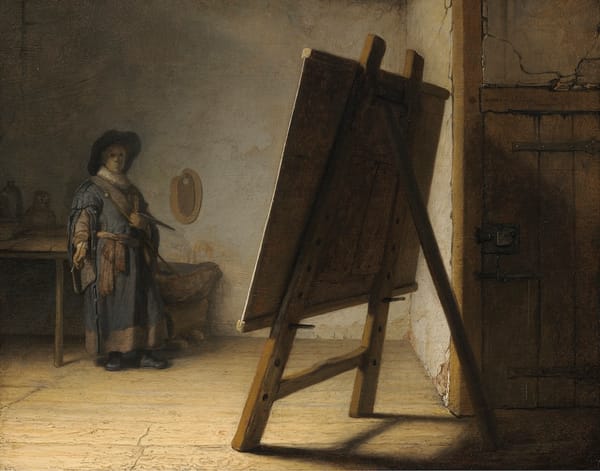‘Anyone Can Do That’: Debunking Misconceptions About Abstract Art
Dismissed as child’s play or meaningless decoration, abstract art is often misunderstood. Far from random splashes, it is rooted in history, philosophy, and skill — challenging viewers to engage emotionally and intellectually.

Walk through any modern art gallery and you are bound to overhear a familiar refrain muttered at least once: “Anyone can do that.” The words are usually directed at a bold canvas of geometric shapes, a splash of colour that appears haphazard, or a minimal line cutting across an otherwise empty surface. Abstract art, more than perhaps any other genre, continues to divide viewers. To some, it is profound, even spiritual; to others, it is an elaborate joke played by artists and dealers upon a gullible public.
But behind that dismissive phrase lie complex misunderstandings. To say that anyone can do it is not entirely false – after all, anyone can pick up a brush and apply paint. The real question is whether anyone can conceive, execute, and contextualise a work of abstract art in a way that holds meaning within the broader language of art. To dismiss abstraction as child’s play is to overlook both its historical significance and its intellectual depth.
This article unpacks the common misconceptions about abstract art, tracing its origins, examining why it provokes such reactions, and asking why it remains a vital mode of artistic expression today.
The Birth of Abstraction
Abstract art as we know it emerged in the early 20th century, a period of rapid cultural upheaval. Artists such as Wassily Kandinsky, Kazimir Malevich, and Piet Mondrian began moving away from representational painting. Instead of depicting recognisable scenes or figures, they pursued pure form, colour, and line.
For Kandinsky, abstraction was tied to spirituality. He believed that colour and shape could evoke emotions in the same way music does, unbound by literal representation. Malevich’s Black Square (1915) represented a radical break – an attempt to create a new visual language for a new age. Mondrian, meanwhile, sought harmony and universal order through his grids and primary colours.
None of this was arbitrary. These works were not “random splashes” but carefully considered visual systems. They required a deep engagement with philosophy, mathematics, music, and theosophy. To reduce them to “something a child could paint” is to misunderstand both their context and their intent.
Misconception 1: Abstract Art Lacks Skill
A common assumption is that abstract art requires no technical skill. Unlike the Old Masters, who spent years mastering perspective, anatomy, and the play of light, abstract artists seem, to the untrained eye, to be doing less.
But the reality is that many abstract painters began their careers with rigorous training in traditional methods. Pablo Picasso, often remembered for his fractured Cubist forms, was an accomplished realist painter by his teens. Jackson Pollock, whose drip paintings epitomise gestural abstraction, studied under respected figurative artists before developing his radical style.
The skill lies not only in technical ability but in control, vision, and the capacity to express meaning through reduction. Just as a poet can capture the essence of a feeling in a haiku rather than a lengthy novel, abstract artists distil their vision into minimal elements.
Misconception 2: Abstract Art Is Random
The apparent spontaneity of abstract art often leads to the assumption that it is random – mere splattering of paint without thought.
Take Pollock’s action paintings as an example. While the drips and splashes may appear chaotic, studies have shown that his canvases exhibit fractal patterns – a mathematical order within seeming disorder. His work was the result of intense experimentation with movement, rhythm, and balance.
Similarly, Mark Rothko’s glowing colour fields were anything but random. Each canvas was the product of painstaking layering, subtle modulation, and an acute sensitivity to how colours interact. Viewers often describe being moved to tears by Rothko’s paintings – hardly the reaction to randomness.
Misconception 3: Abstract Art Has No Meaning
Another widespread belief is that abstract art is meaningless – just decoration without substance. This overlooks the fact that abstraction often arises from deep philosophical or political impulses.
Malevich’s Suprematism was tied to ideas of liberation from materialism. Mondrian’s grids expressed a utopian vision of universal harmony. In India, S.H. Raza’s bindu series drew upon metaphysical concepts rooted in Hindu philosophy. For many artists, abstraction offered a way to express the inexpressible: emotions, spiritual truths, or critiques of society.
Meaning in abstraction may not be literal, but it is no less real. It shifts from external representation to internal resonance. Instead of telling a story about the outside world, abstract art creates a space for introspection.
Why “Anyone Can Do That” Feels True
So why does the accusation persist? Part of the answer lies in the democratic nature of abstraction. Unlike Renaissance painting, which demands knowledge of biblical stories or classical mythology, abstraction is accessible on a surface level. Viewers do not need specialised knowledge to recognise a splash of red paint or a black square.
This familiarity can breed contempt. If a canvas looks like something we ourselves might have created, we are tempted to dismiss it. The irony is that this is precisely what makes abstract art powerful. By stripping away representation, it forces us to confront colour, form, and texture in their raw state – elements so fundamental that they invite everyone to respond.
The Role of the Viewer
Abstract art is less about the artist dictating meaning and more about inviting the viewer to participate. Kandinsky compared abstraction to music: just as a symphony evokes feelings without representing anything concrete, so too can a painting of pure forms.
This active role for the viewer can be unsettling. It places responsibility on us to bring our own emotions, memories, and interpretations to the work. Not everyone welcomes that challenge. It is easier to laugh off a canvas than to admit we are unsure how to engage with it.
Abstraction in the Contemporary World
Far from being a historical curiosity, abstraction remains central to contemporary practice. Today’s artists build upon the foundations laid a century ago, experimenting with digital media, installation, and cross-disciplinary approaches.
For example, artists such as Julie Mehretu create vast, layered works that blend abstraction with references to architecture, history, and politics. Others, like Anish Kapoor, explore abstract form in three dimensions, using sculpture to evoke the sublime.
Even outside galleries, abstraction has shaped design, advertising, and architecture. The clean lines of modernist buildings, the bold patterns of textiles, even the visual language of tech interfaces owe much to abstract art’s legacy.
Learning to See Abstract Art
Engaging with abstraction requires a shift in mindset. Instead of asking, “What is this supposed to be?” we might ask, “What does this make me feel?” or “How do the colours and forms interact?”
Here are a few practical approaches for viewers:
- Spend Time – Abstract art often reveals its depth slowly. Stand in front of a Rothko for more than a few seconds and you may notice subtle shifts in light and mood.
- Consider Context – Understanding the artist’s influences and historical moment can enrich appreciation. Kandinsky’s colours resonate differently when you know his belief in synaesthesia.
- Trust Your Response – There is no single correct way to interpret abstraction. If a work makes you feel joy, confusion, or even irritation, that response is part of its success.
- Compare Works – Looking at several paintings side by side can reveal how artists manipulate form and colour differently.
The Lasting Value of Abstraction
Abstract art has endured for more than a century not because it is easy but because it continues to challenge, provoke, and inspire. It forces us to rethink what art can be. It democratises the visual field, making room for individual interpretation rather than prescriptive narratives.
The phrase “Anyone can do that” misses the point. The question is not whether you or I could replicate the brushstrokes of a Pollock or the geometry of a Mondrian, but whether we could have conceived of such an approach in the first place – and placed it within the cultural dialogue of art.





